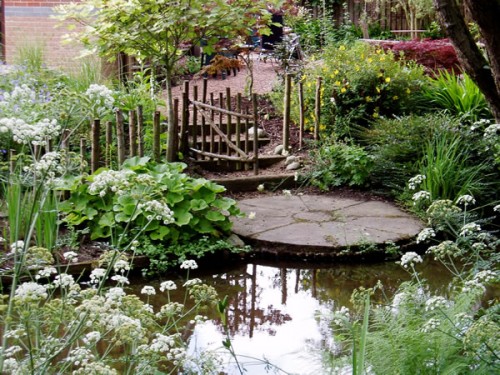THE WATERSIDE GARDEN
New York State, USA
The garden called Innisfree is not what it seems. It is not in Ireland, as one might expect, but in New York State. And it could not be further from Irish scenery, design or plants: it was inspired by Chinese landscape and gardens. This is how it happened.
Originally called Millbrook, Innisfree was the family home of Marion Beck, whose husband, Walter, was an artist and teacher. When they moved there in the 192.os, they changed its name to Innisfree in homage to W.B. Yeats's poem 'The Lake Isle of Innisfree'. Why? The garden has no nine bean-rows and no hive for the honeybee as the poet suggests, but it held the same promise of simplicity and peace as the poem, which is deeply romantic. What happened to Innisfree is equally so.
The house Marion Beck inherited was surrounded by 300 hectares (740 acres) of rolling hills, natural woodland and outcrops of stone. At its centre was the i6-hectare (40-acre) Lake Tyrrel. Walter Beck, who trained at the Royal Academy of Fine Arts in Munich and later taught at the Pratt Institute in New York, became enthused by black-ink brush paintings of the Chinese landscape and calligraphic scrolls, especially those of Wang Wei, an eighth-century artist who used his own gardens and buildings as subjects for his paintings. From 1930 until Marion Beck died in 1959, they used the inspiration of Wang Wei's garden scrolls to create their own garden. Later, their protege, Lester Collins, a landscape architect whose views coincided with their own, took on Innisfree until his own death in 1993.
Using the natural glacial lake as the garden's centre, the Becks constructed a series of intimate 'cup' gardens, each one separate and distinct from the next and each creating its own self-contained scene. In each, the intention was to create asymmetrical spaces that combined rhythm and pattern with space and form, as in the Chinese scroll paintings they studied.
Because this was to appear a natural landscape, the garden largely relied on plants from the surrounding woods to create the scenery. These were carefully planted and pruned into artistic but natural shapes. The Becks used the rocks left by the glacier — sandstone, limestone, granite and quartz — to make the stone sculptures essential to Chinese gardening. Each was moved into its precisely planned space and positioned to give just the right punctuation mark. Water from the lake was pumped into a huge reservoir hidden in the hillside, from which a series of underground pipes fed the man-made pools, waterfalls and sculptures that enliven each garden 'picture'. Lester Collins's contribution was to apply Japanese skills to these Chinese-inspired pictures. He worked to make links between the various cup gardens, so that visitors would walk from one set scene to another, a concept known as a 'stroll' garden.
Today, the house, which was in the twentieth-century Queen Anne style — somewhat heavy but less lowering than the Victorian country house — has gone. It was demolished in 1982 as not being in keeping with the garden. The garden itself has been reduced to 6o hectares (15o acres), and, since Collins's death, Innisfree has been run by a trust, which opens the garden to the public.

No comments:
Post a Comment